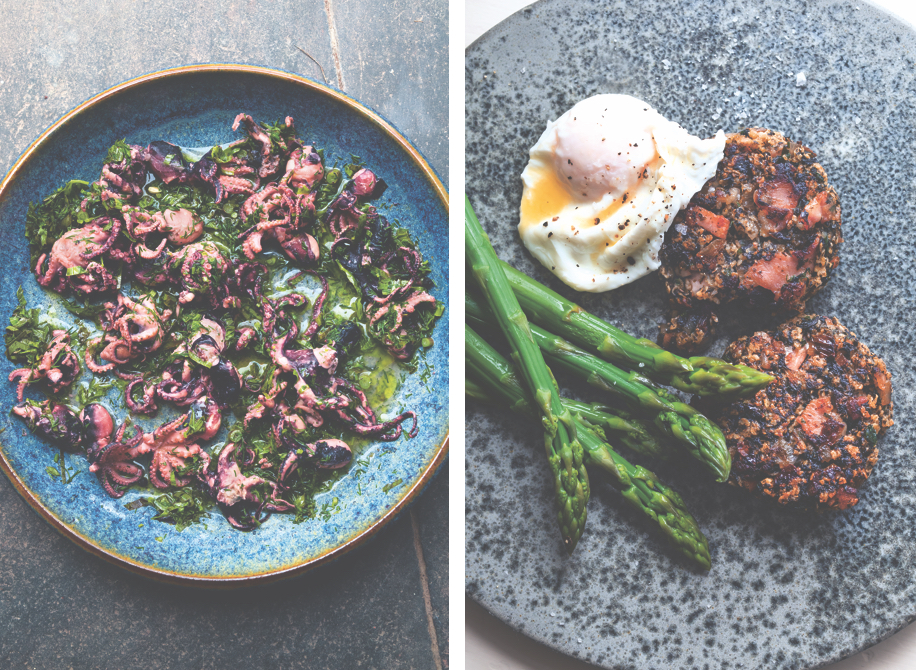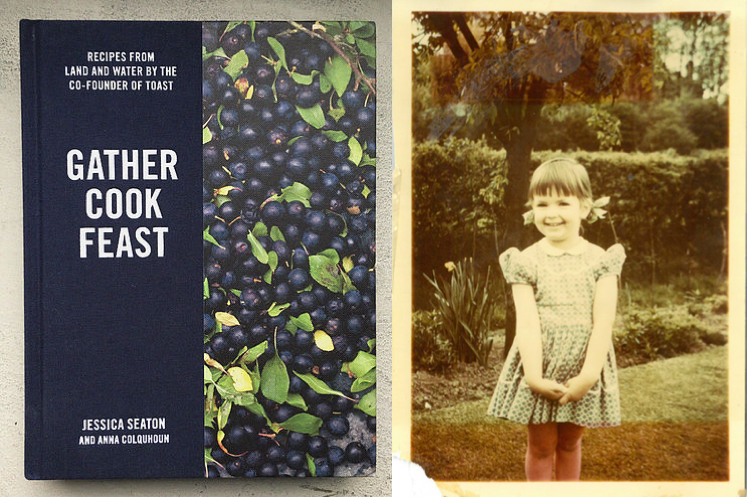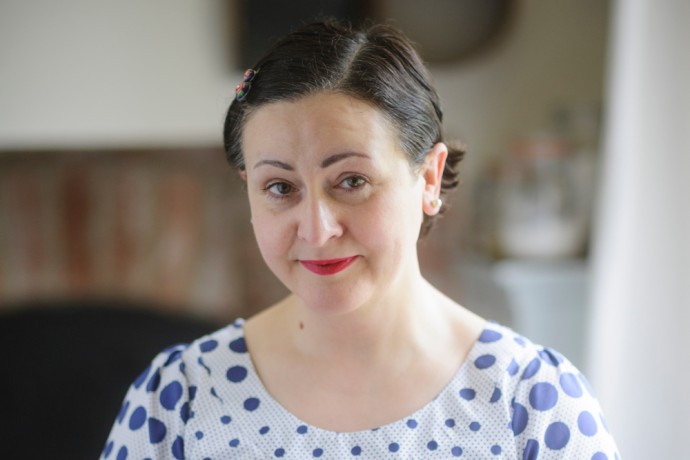“Gather Cook Feast” with Jessica Seaton from TOAST
Food has always been central to Jessica Seaton’s life. The proof is in TOAST, the name she bestowed upon the lifestyle brand that she co-founded with her husband, Jamie Seaton, twenty years ago. From its inception, the brand has always stood out for its thoughtful and functional clothing (him) combined with a distinct and evocative imagery for which their catalogues and look books are infamous (her). The clothes are a firm favourite amongst creatives like Polly Leonard, the founder of Selvedge Magazine and Deborah Thomas, of Doe Leather.
With the launch of her first solo project, recipe book “Gather Cook Feast, Recipes From the Land and Water”, Jessica explores her fascination with the relationship between food and the landscape from where it comes. And acts boldly on her desire to create, “a plate that feels like a place”. The book’s recipes — over one hundred and twenty — and its accompanying photographs transport you to a world where the body and soul are forever noursished. Think TOAST but this time with an edible result. The offer and Jessica are difficult to resist. Read on and see why.

Fabulous Fabsters: Your creativity is inextricably linked to your family and surroundings. Please tell us a little about how that started.
Jessica Seaton: I have built two businesses with my husband, Jamie. The first, a knitwear business, started as a very small seed of an idea, but after a couple of years, through coincidence or application, we found it developed its own momentum. That business opened our eyes to the world. And when the momentum faltered we decided we needed a change and so we started Toast, which has been our life and inspiration since.


FF: What was your inspiration for your first solo project, “Gather Cook Feast”?
JS: It was really about the coming together of two things that I deeply love – food and landscape. When asked what sort of book we might like to publish the idea came from nowhere with such conviction that it couldn’t be ignored. Thus I can now combine my work at Toast, working with photographers and designers with my love of food, cooking and landscape. “Gather Cook Feast” is about food as an expression of landscape – a plate that feels like a place, if you will. I am interested in food and this sense of place, the tingle down the spine, loving life, discovery and the reward of a job well done, science, a new world, arranging words, empty spaces, Japanese aesthetics, the wilderness, gloomy music, the profound, making a new world, cherishing the natural world, being buried on a bed of wild flower hay.


FF: The images in the Toast look books consistently evoke a “sense of place”. Can you discuss how this developed into “a plate that feels like a place”?
JS: It is true that Jamie and I have always wanted to build a sense of place into the books Toast has published over the years. It was never a plan, we just responded to the beauty we saw, especially seen through the eyes of some of the amazing photographers we have worked with.
We have always thought that the making of the clothes and taking of the photographs as two halves of the work – a completion of the work if you will. It becomes more than just making a pair of trousers or a dress. And we always wanted to express something amazing: something to open the eyes and heart. This the aspiration — how much we succeed is up to others to decide.
And so with “Gather Cook Feast” it is the same impulse applied to food. I wanted to create a deep connection between place and the foods you take into your body and are sustained by. There is an intimacy to eating, the play of texture and taste in the mouth and I love it when foods evocatively betray their origins: a flinty wine from a limestone plateau; the sweet-salty taste of lamb grazed on the sea marshes; the intensely autumn-y taste of a meaty cep. It’s all wonderful to me.


FF: The relationship between the landscape and food is a powerful idea that you explore in depth in “Gather Cook Feast”. Please elaborate on how you expressed the inextricable ties between the two in your choice of images and words.
JS: The book is arranged into six chapters that take you through the year; ‘Freshwater’, ‘Saltwater’, ‘Home Ground’, ‘Field & Pasture’, ‘Heath & Wood’, and ‘Upland’. For me each place had a felt atmosphere and I wanted to communicate the individual feeling of each — a time of year, its colours, its flavours. And so, for example, the ‘Saltwater’ section is not only about fish and seaweed, which come from the sea; but also about brining, lemon and pickles, which feel somehow like the slap of a sharp wave when swimming. In another example, the opening chapter, ‘Freshwater’, is full of green — that vibrant spring growth, which is sometimes so green it can hurt your eyes.
Each chapter starts with a list of words that express these feelings I have for each place and are interspersed with ingredients that are from each place. There are also photographs of each landscape, taken by our son, Nick Seaton. He captured these images by touring the country over the course of a year.


FF: Please tell us how this relationship between the landscape and food clearly nourishes your mind, body and soul.
JS: I have been thinking about this a good deal lately and am cautious about being too evangelistic. But I think many people feel the need to have a relationship with the natural world and that living in cities where it’s hard to see the sky and stars can weaken that connection. Your eye cannot roam the distance and that makes it hard to step out with an uninterrupted stride.
FF: How does foraging fit into this for you?
JS: In “Gather Cook Feast”, I intentionally use a selection of foraged ingredients. Mostly because foraging is an enjoyable practice — getting out into the open air and eating foodstuffs packed with nutrition and complex compounds that have been bred out of many domestic cultivars. It’s very rewarding and the foods you can find are rich in vitamins and minerals as well as tasting, well…. more alive and wild.
FF: How might the uninitiated begin to forage?
JS: To begin foraging is to reconstruct a knowledge that has, until quite recently, largely been lost to the vast majority of people. If you don’t know your way around the British flora, it will be best to take a course first and then to equip yourself with some good foraging books — I recommend some courses and references in the book. And finally practise, practise, practise. The easiest plants to start with are some of the more well-known ones: blackberries, nettles, elderberries and elderflowers. They are also some of the most delicious.


FF: Your memories of your childhood home are, thanks to your mother, filled with “the scent of cooking and the energy of possibility”. What memories do you think your children have of you and food?
JS: The memories of my mum’s food are quite simple really. Her food wasn’t elaborate but she cooked very well indeed and was always curious about new tastes and new ideas. There was a wonderful generosity to the way she cooked – whether it was a wonderful impromptu picnic with roast chicken, crusty bread, tomatoes and red wine or a Sunday tea with the lightest of sponge cakes’ oozing cream and fruit. She made the best trifle I have ever tasted and when I was very young and hanging around stables, the other stable hands used to plead with me to ask her if she would also make them the two-layer, over stuffed baguette sandwiches that she made for my packed lunch. She did too! All this was years ago when sandwiches were mostly made with a sandwich spread that came from a jar.
I had to ask my children what they remember. Rachel said she remembers artichokes, and skate with capers and beurre noir. Nick said he remembers the sounds of my cooking when he played in the garden on summer evenings and school packed lunches that were embarrassingly smelly.
FF: What would you like the reader to take away from “Gather Cook Feast”?
JS: I would love them to just enjoy cooking and eating the food, to feel a sense of space and open air and to be tempted to try something new.

FF: Any Wardrobe Wisdom?
JS: A good while ago I embarked on the Marie Kondo de-cluttering and suddenly realised what my style was! I would recommend going through this process to anyone who is unsure about their style. The remaining items left on my rails and in my drawers were very consistent and clear in their simple shapes, style, proportion and neutral colours.
And buy better if you can.
FF: What’s in your Prescient Pantry?
JS: Neal’s Yard Yoghurt, nuts of all sorts, good sea-salted butter, best Tuscan olive oil, bang fresh free-range eggs, a good block of very well made artisan cheese, a loaf of sourdough bread, a bowl of tomatoes kept out of the fridge, a large bulb of garlic and anchovies.

FF: How do you stay strong and well in body and mind?
JS: Yoga, pilates, walking and Buddhism.
FF: If you have any messages to your younger self, what would they be?
JS: It’s OK, honestly.
FF: What do you hold most dear to your heart?
JS: My family.

A Fabulous Fabster thank you to Jessica Seaton!



Honestly can’t tell you how much joy this blog brings me! Lovely to see you posting more often lately. The space is so energetic and intimate.
Many thanks for your kind comment. I’m so glad you enjoy reading about all these wonderful and talented women. It brings me great joy to tell people about them. All the best, Christine